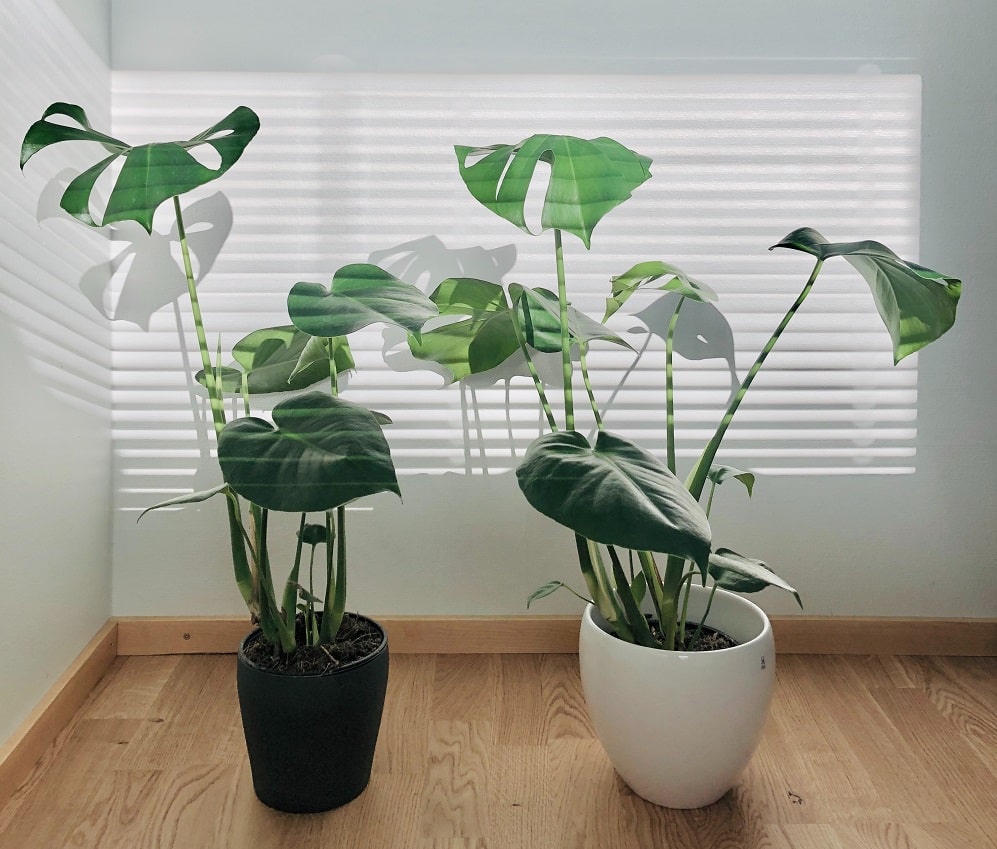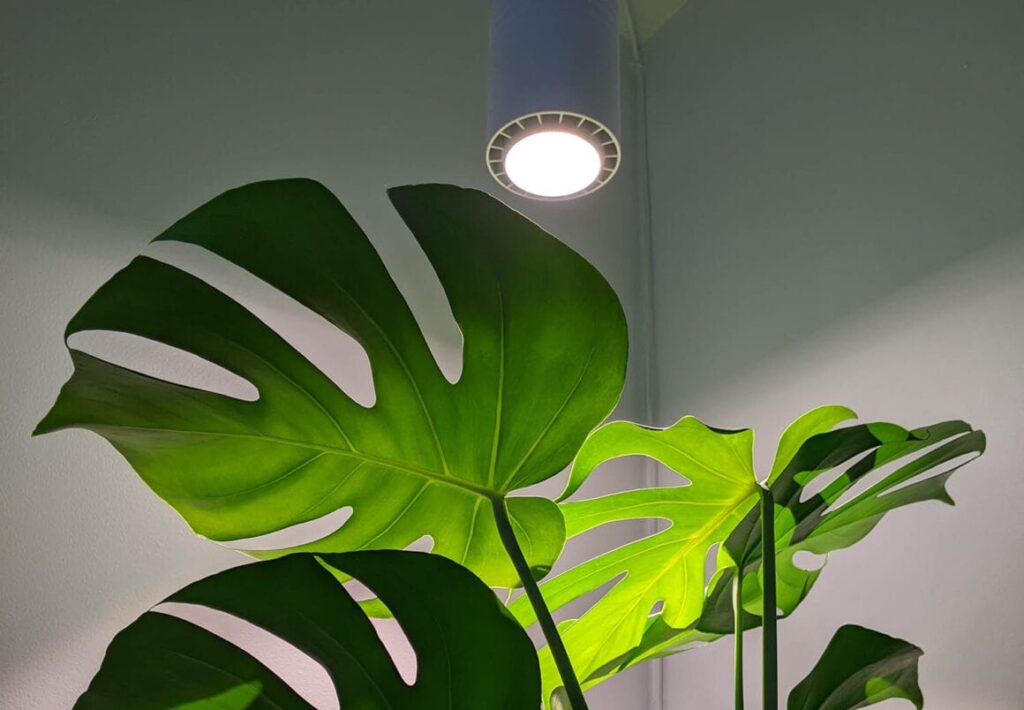Monstera leaf fenestration is one of the unique features that make this plant adapt to the indoor environment. It is also a feature that makes this tropical plant stand out from others.
But there are instances when your monstera leaves will delay or not fenestrate at all. There is no need to freak out since the issue can easily be fixed.
So, why are my monstera leaves not splitting? Possible causes are young age, low lighting, nutrient deficiencies, underwatering, low humidity level, and more.
Identifying the factors that inhibit monstera leaves from splitting would help to fix them. This article provides a comprehensive insight into the causes and remedies.
You May Also Like: Why Are My Monstera Leaves Turning Yellow?

Why Do Monstera Leaves Split? (Fenestration)
Fenestration is the term used to describe the holes and splits on monstera leaves. Monstera leaf fenestration usually occurs after the age of 2-3 years old.
Monstera is commonly found under the canopy in the rainforest. Access to sufficient sunlight is quite challenging and the plant has to find ways to survive in such an environment.
So, why do monstera leaves split? To help trap scattered sun rays, tolerate strong wind, increase access to water, and more.
Let’s find out how leaf splits help monstera plants survive in their natural habitat. These survival features also help this tropical plant withstand indoor growing conditions.
Absorb Sunlight
Sunlight is crucial for green plants. It helps in the manufacture of food and also enhances the absorption of water from the soil by roots.
The leaves with splits and holes increase the surface area for trapping the scattered sun rays under the rainforest canopy.
It is an incredible feature to allow the plant to tolerate low light. Thus, enabling the plant to survive under bright indirect sunlight in the house.
You Can Also Read: How to Care for Monstera Adansonii
Improve Access to Water
The natural habitat of monstera is characterized by heavy rainfall. The leaf splitting feature helps to keep the rain off as much as possible.
The splits on the leaves usually divert water to the nodes and root areas. Wet leaves are known to result in a lot of trouble like rotting, fungal, and bacterial diseases.
Fenestration prevents water from sitting on the leaves for long. It is the best way to prevent major leaf problems on monstera plants.
Tolerate Strong Wind
There is little wind in the natural habitat of monstera plants. Thanks to the tall trees and large canopies that help to prevent strong winds from reaching the plant.
But monstera is an invasive species and can survive in any area. Leaf splitting enables the plant to adapt to windy conditions when grown at home.
The splitting protects the plant from being knocked by a strong wind. Monsteras can adapt to harsh growing conditions with ease.
You Can Also Read: Why Is My Monstera Dying?
Why Does My Monstera Leaves Not Splitting?
Every gardener expects their monstera leaves after adopting one. But there are some instances where fenestration might not happen.
Below are the possible reasons for monstera leaves not splitting:
Still too Young
Age is a crucial factor to put into consideration in case your monstera leaves are not having fenestration. Do not expect young monstera plants to start splitting leaves.
Fenestration usually happens when the plant is about 2-3 years old. If your beauty is not yet, there is no need to raise concerns.
If this tropical plant does not split leaves after the expected period, you need to dig deeper and find out the cause of the problem.
Insufficient Sunlight
Monstera plants can tolerate low lighting. But if the plant is not getting enough light, it is likely to experience slow growth.
Insufficient sunlight makes monsteras produce small leaves which cannot experience fenestration in the long run.
The leggy growth and other disturbances brought about by inadequate sunlight could be the possible reason behind leaves not splitting.
Nutritional Deficiencies
Monsteras are not heavy feeders. But monthly fertilizer application during the growing season is highly recommended. The nutrients help the plant produce larger and healthier leaves.
Watering and Humidity
Monsteras require more water and high humidity. Underwatering and low humidity could make your houseplant leaves not have fenestrations.
High humidity levels and adequate water help the plant produce large leaves. Keep in mind that the natural habitat of monstera experiences heavy rainfall and has high humidity.
You May Also Enjoy: Why Are Variegated Monstera So Expensive?
How to Encourage Monstera Leaves to Split
Split leaves make an incredible statement in your living lounge or office. Below are some of the tips to encourage monstera leaves to split:
Expose the Plant to Bright Indirect Light
Light is the most essential factor that promotes fenestration in monsteras. Those plants located in a shady area rarely split leaves at home.
Make sure your beauty is placed in a region where there is bright indirect light. I recommend placing the houseplant near the window.
You can also grow the plant under artificial light in case the sunlight is not enough. Ensure the light is not too much to scorch the leaves.
Consistent Watering Routine
Tropical plants love water since their natural habitat is marked with heavy rainfall. But you need to monitor your watering routine to avoid overwatering issues.
I recommend watering your beauty once a week during spring and summer. Water the plant about twice a month during winter.
The rule of thumb is to check the moisture content of the soil before watering. Ensure the 2-3 inches of the topsoil is dry before watering.
Apply Fertilizer to the Plant
Monstera needs nutrients like other plants. But they are not heavy feeders. You need to supply the plant with weak fertilizer during their growing season.
Adequate nutrients help the plant to produce large and healthier leaves. These leaves will later experience fenestration.
Remember not to fertilize monsteras during winter. It is the period where the plant is dormant and the nutrients from fertilizer will turn out toxic.
Provide Optimum Humidity and Temperature
Monsteras prefer high humidity and temperature. Ensure your indoor growing conditions mimic the natural habitat of this tropical plant.
You can opt to install a humidifier to increase humidity indoors or move your houseplant to the bathroom where the humidity level is high.
Another incredible option is misting the monstera leaves weekly. It helps to increase the humidity level around the plant.
Remember to move the plant away from heat sources and air conditioning vents. Excess heat will make the plant droopy and even get scorched.
Consider Repotting the Plant
Monsteras grow faster and usually overwhelm the growing pots. Failure to repot the plant will damage the root system due to the limited space available for growth.
Repotting should not be often. I recommend investigating your plant and seeing if it has overgrown the current pot before you consider repotting.
Spring is the best season to repot your plant. It is the period where the plant is pushing out new growths. Large pots are ideal since they create adequate space to accommodate the growing roots.
Pruning Old Foliage
Monsteras can be bushy when offered a better growing environment. I recommend cutting off the old leaves to create room for new foliage.
Pruning also helps to inhibit monstera vines from growing all over the house. Removal of old leaves enables the plant to divert the energy and nutrients to the new growth.
Combat Pests and Diseases
Monstera is less resistant to pests and diseases. These two factors are known for hindering the health of the plant and its leaves.
Some of the common pests infesting the plant are spider mites, mealybugs, thrips, and aphids. These insects usually pierce the leaves and suck nutrients.
The tiny holes create an ideal environment for diseases to spread. The best option is to use a cotton swab dipped in insecticidal soap to kill the pests.
You May Also Like: Why Are Arrowhead Leaves Turning Yellow?

Frequently Asked Questions
When Do Monstera Leaves Split?
Monsteras start splitting after reaching the maturity age of 2 to 3 years. Juvenile monsteras will not split leaves until they attain maturity age.
Do All Monstera Split Leaves?
Not all monsteras split leaves. There are some monstera varieties that do not experience fenestrations. But these varieties are quite rare. Keep in mind that young monstera plants do not split leaves.
Why Are My Monstera Leaves Tearing?
It is usually due to mechanical damage. Sometimes the leaves may develop cracks when the air is too dry or a fan is blowing close to it. Monstera leaves are large and can easily be walked into it.
Do Existing Monstera Leaves Split?
Absolutely. But this is possible once the plant has attained the maturity age. Young monsteras do not fenestrate at all.
Do Monstera Leaves Split After Unfurling?
Yes. The leaves will begin to split so long as the plant is 2-3 years old. Even young leaves will have fenestration during that period.
In Conclusion
Young monstera plants would not fenestrate right away. Do not be frustrated but wait until the houseplant has attained the age of 2-3 years old.
The Swiss Cheese Plant splits and holes help to make a statement in your house. The fenestration creates unique features for decorating your home.
If you are looking forward to witnessing this attractive splitting of monstera leaves, try to exercise more patience. Provide good growing conditions and requirements for better results.
More Sources and References
- Susan Mahr. Monstera Deliciosa. Wisconsin Division of Extension.
- C. Fendy. Leaf-Split Not Splitting. Houzz.
- Editor. Monstera Deliciosa. Wikipedia.
